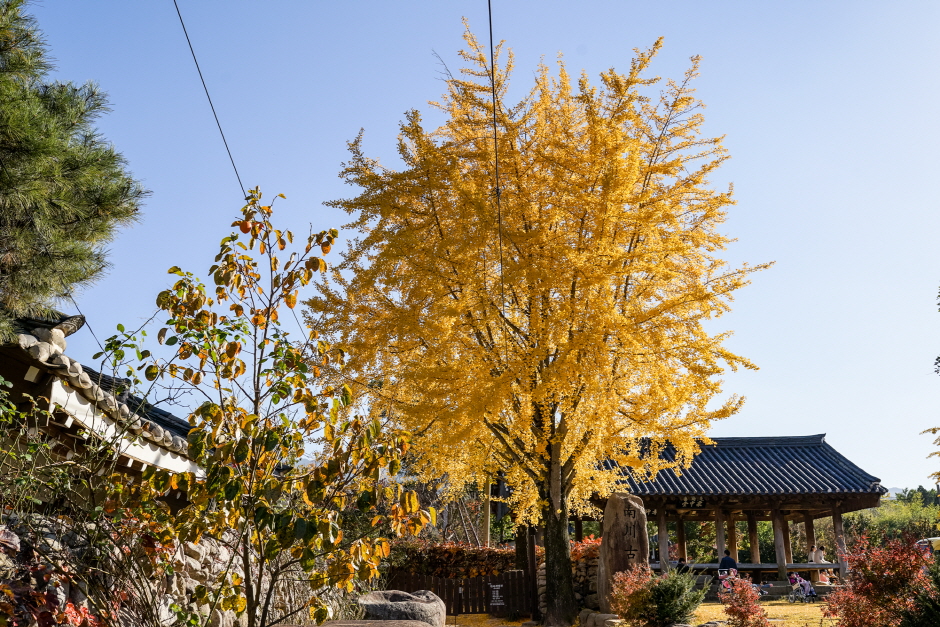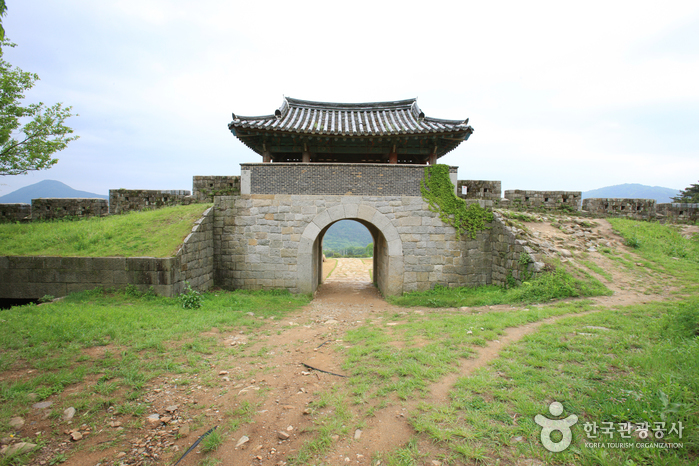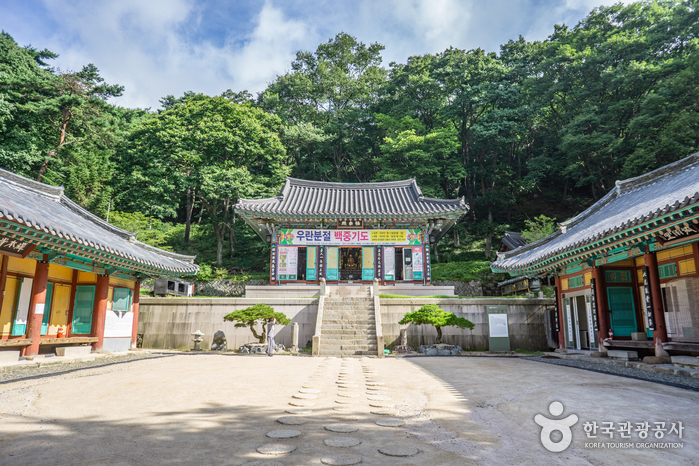Palgongsan Nature Park (Gatbawi District) (팔공산자연공원(갓바위지구))
5.6Km 2024-02-29
6-1 Palgongsan-ro 199-gil, Dong-gu, Daegu
+82-53-939-0080
Palgongsan Nature Park, located in the Taebaek Mountain Range, features three peaks: Birobong Peak (1,192m), Yeombulbong Peak (1,042m), and Seobong Peak (1,150m). This mountain area boasts stunning rock formations and valleys. At an elevation of 852 meters on Gwanbong Peak, the Gatbawi Rock is renowned for fulfilling wishes. Other attractions include Donghwasa Temple, the Palgongsan Cable Car, and the Donghwasa Tourist Complex.
Hanbam Village (한밤마을)
6.1Km 2025-10-23
2137-3 Hanti-ro, Bugye-myeon, Gunwi-gun, Daegu
◎ Travel information to meet Hallyu’s charm - TV series"The Good Bad Mother"
Serving as the inspiration for Jowoori Village in the show “The Good Bad Mother,” this charming village under the Palgongsan Mountain retains the picturesque stone walls and sceneries of rural Korean villages. If you were a fan of the show, head to Hanbam Village and walk along the stone walls to re-live your favorite scenes.
Daegu Donghwasa Temple (동화사(대구))
6.2Km 2025-08-11
1 Donghwasa 1-gil, Dong-gu, Daegu
Donghwasa Temple is located on the south side of Palgongsan Mountain, about 22 km northeast of Daegu. It was built by Monk Geukdal in the 15th year of King Soji’s reign (AD 493). The original name of the temple was Yugasa Temple, but Simjiwangsa rebuilt the temple under King Heungdeok (r. AD 826-836) and named it Donghwasa Temple, which means "the paulownia tree blooms even in winter," in reference to the blooming trees around the temple. Most of the present temple buildings were constructed between 1723 and 1732.
Chilgok Gasansanseong Fortress and Gasanbawi Rock (칠곡 가산산성 및 가산바위)
6.2Km 2025-01-08
Gasan-ri, Chilgok-gun, Gyeongsangbuk-do
+82-54-979-6452
Gasansanseong Fortress in Chilgok-gun, Gyeongsangbuk-do is located in the middle of Chilgok-gun, between Daegu Metropolitan City and Gumi. Gasansan Mountain (901m in elevation) is 10 kilometers west of Palgongsan Mountain. Because it boasts seven peaks, the mountain was called Chilbongsan Mountain. After enduring foreign invasions, including the Imjin War (1592-1598) and the Qing invasion of Joseon (1636), the Joseon rulers built a fortress over the course of 100 years to aid in Korea’s defense. It is Korea’s only three-layered fortress, consisting of inner, outer and central walls. The flat Gasanbawi Rock at the mountain’s peak, which is large enough to accommodate 100 people at a time, offers a great view of Daegu Metropolitan City.
Gooam Farmstay Village (구암팜스테이마을)
7.0Km 2024-03-15
8-1 Guam-gil, Dong-gu, Daegu
+82-53-984-5273
Known as "Gooam" due to its rock formations resembling turtle's shell, Gooam Farmstay Village offers various activities such as harvesting agricultural produce, traditional food making, traditional games, and craft experiences. Depending on the season, there are experiences like picking strawberries, digging potatoes, picking cherry tomatoes, gathering chestnuts, and harvesting persimmons. Visitors can also participate in making bean curd, rice cakes, kimchi, catching loaches, making kite, and experiencing hanji crafts.
Bumbine (붐비네)
7.1Km 2025-10-30
54 Pagye-ro 6-gil, Dong-gu, Daegu
Holy place for SHINee fans
It is a small Tteokbokki restaurant in front of an elementary school without a prominent sign, but it is a must-visit place for SHINee fans. It was because Key stopped by every day when he was in elementary school. It is fun to see the store filled with SHINee's albums and photos. Sweet Tteokbokki with a lot of cabbage is not irritating, so you can eat it without burden. If you mix this with Daegu's specialty Flat Mandu, it's the best combination. Listening to the pleasant story of the owner of this restaurant creates new memories.
PyoChungJae Experience Center (표충재 전통체험관)
7.2Km 2024-08-01
17 , Sinsunggyeom-gil, Dong-gu, Daegu
+82-53-428-9980
Pyochungjae Hanok stands within the General Shin Sung-gyeom Historic Site in Dong-gu, Gyeongsangbuk-do, and is a quiet spot surrounded by beautiful scenery. Rooms incorporate a toilet and modern bathroom, with a shared kitchen and additional toilet outside. Traditional pastimes such as archery, Yutnori and Neolttwigi can be enjoyed in the hanok yard. Pyochungjae is just 10 minutes from Daegu International Airport and 30 minutes from the center of Daegu. Donghwasa Temple is 15 minutes and Palgongsan and Gatbawi Rock 20 minutes away. The hanok is not always open during winter, so prior booking is required.
MRNW Miraenongwon (MRNW)
9.0Km 2023-11-09
300-22 Hoguk-ro, Buk-gu, Daegu
MRNW, standing for Miraenongwon, was started with the idea of creating a space one dreams about but does not exist in real life. Locating in nature, MRNW provides a space to enjoy exhibitions, culture, art, and dining all at once.
Palgongsan National Park (Eunhaesa Temple Section) (팔공산국립공원 - 은해사지구)
9.3Km 2025-04-08
Geojo-gil, Yeongcheon-si, Gyeongsangbuk-do
+82-54-852-8031
Located east of Daegu downtown, Palgongsan Mountain (1,192.3m) was called both Jungaksan and Buaksan Mountain during the Silla period. The mountain has many ancient temples and historical sites such as the Gatbawi Stone Buddha, Wonhyosa Temple, Cheonseongsa Temple and Bulgulsa Temple.
Gyeongsan Seonbonsa Temple (선본사(경산))
9.4Km 2021-12-02
699, Gatbawi-ro, Gyeongsan-si, Gyeongsangbuk-do
+82-53-851-1868
Seonbonsa Temple is a centrally administered temple of the Jogye Order. It was originally built in 491 by Geukdal, and later repaired in 1641. The temple is home to many important cultural treasures, including the Stone Seated Buddha at Gwanbong Peak (Treasure), Three-story Stone Pagoda (Gyeongsangbuk-do Cultural Heritage), and stone lanterns.






 English
English
 한국어
한국어 日本語
日本語 中文(简体)
中文(简体) Deutsch
Deutsch Français
Français Español
Español Русский
Русский